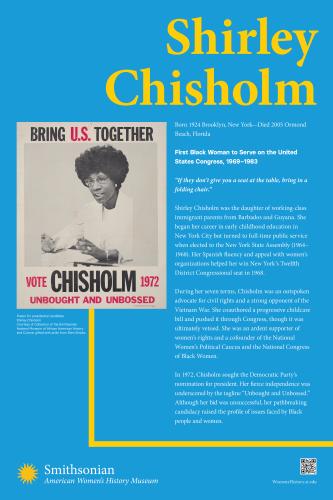
Discover stories of women who opened doors in our nation’s government, from the first woman of color to serve on the United States Congress to the first woman to serve as a Cabinet Secretary, in this poster exhibition that debuted at the White House for Women’s History Month 2023.
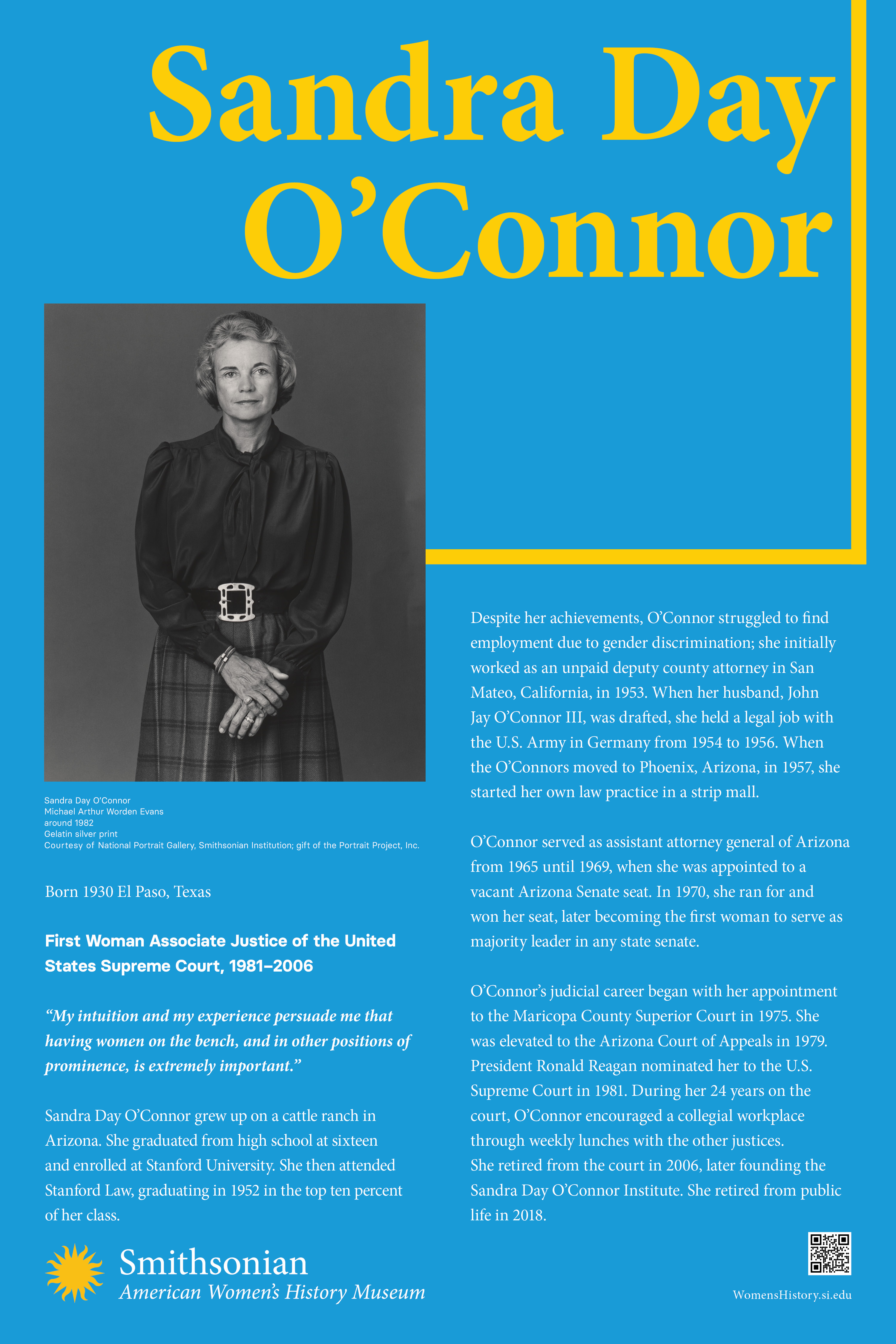
Sandra Day O'Connor
Born 1930 El Paso, Texas
First Woman Associate Justice of the United States Supreme Court, 1981-2006
"My intuition and my experience persuade me that having women on the bench, and in other positions of prominence, is extremely important.”
Sandra Day O'Connor grew up on a cattle ranch in Arizona. She graduated from high school at sixteen and enrolled at Stanford University. She then attended Stanford Law, graduating in 1952 in the top ten percent of her class.
Despite her achievements, O'Connor struggled to find employment due to gender discrimination; she initially worked as an unpaid deputy county attorney in San Mateo, California, in 1953. When her husband, John Jay O'Connor III, was drafted, she held a legal job with the U.S. Army in Germany from 1954 to 1956. When the O'Connors moved to Phoenix, Arizona, in 1957, she started her own law practice in a strip mall.
O'Connor served as assistant attorney general of Arizona from 1965 until 1969, when she was appointed to a vacant Arizona Senate seat. In 1970, she ran for and won her seat, later becoming the first woman to serve as majority leader in any state senate.
O'Connor's judicial career began with her appointment to the Maricopa County Superior Court in 1975. She was elevated to the Arizona Court of Appeals in 1979. President Ronald Reagan nominated her to the U.S. Supreme Court in 1981. During her 24 years on the court, O'Connor encouraged a collegial workplace through weekly lunches with the other justices. She retired from the court in 2006, later founding the Sandra Day O'Connor Institute. She retired from public life in 2018.
Sandra Day O'Connor
Michael Arthur Worden Evans
around 1982
Gelatin silver print
Courtesy of National Portrait Gallery, Smithsonian Institution; gift of the Portrait Project, Inc.
Smithsonian American Women's History Museum
WomensHistory.si.edu
Patsy Mink
Born 1927 Hāmākua Poko, Territory of Hawai`i— Died 2002 Honolulu, Hawai`i
First Japanese American Woman and Woman of Color to Serve on the United States Congress, 1965-1977 and 1990-2002
"We have to build things that we want to see accomplished, in life and in our country, based on our own personal experiences to make sure that others do not have to suffer the same discrimination."
Raised on the island of Maui, Patsy Takemoto graduated valedictorian and president of her high school class. She navigated racial and gender discrimination while studying at the University of Nebraska, and again, in applying to medical school. She chose to attend law school at the University of Chicago, where she met and married John Mink in 1951.
Upon returning to Hawai`i, Mink experienced discrimination in employment for not only being a woman and mother, but also for being part of an interracial marriage. She opened her own law practice and took cases that larger firms often declined such as divorces, adoptions, and other family and women-focused issues.
Mink became the first woman of color elected to the U.S. House of Representatives in 1964, and quickly became a champion of gender equality, civil rights, and education. Mink was a key author for Title IX, which passed in 1972, dramatically changing women's and girls' access to education, including school-sponsored sports. Title IX was later renamed the Patsy T. Mink Equal Opportunity in Education Act in her honor.
Re-Elect Patsy Mink leaflet
around 1966
Courtesy of Division of Political and Military History, National Museum of American History, Smithsonian Institution; gift of Patsy Mink
Smithsonian American Women's History Museum WomensHistory.si.edu
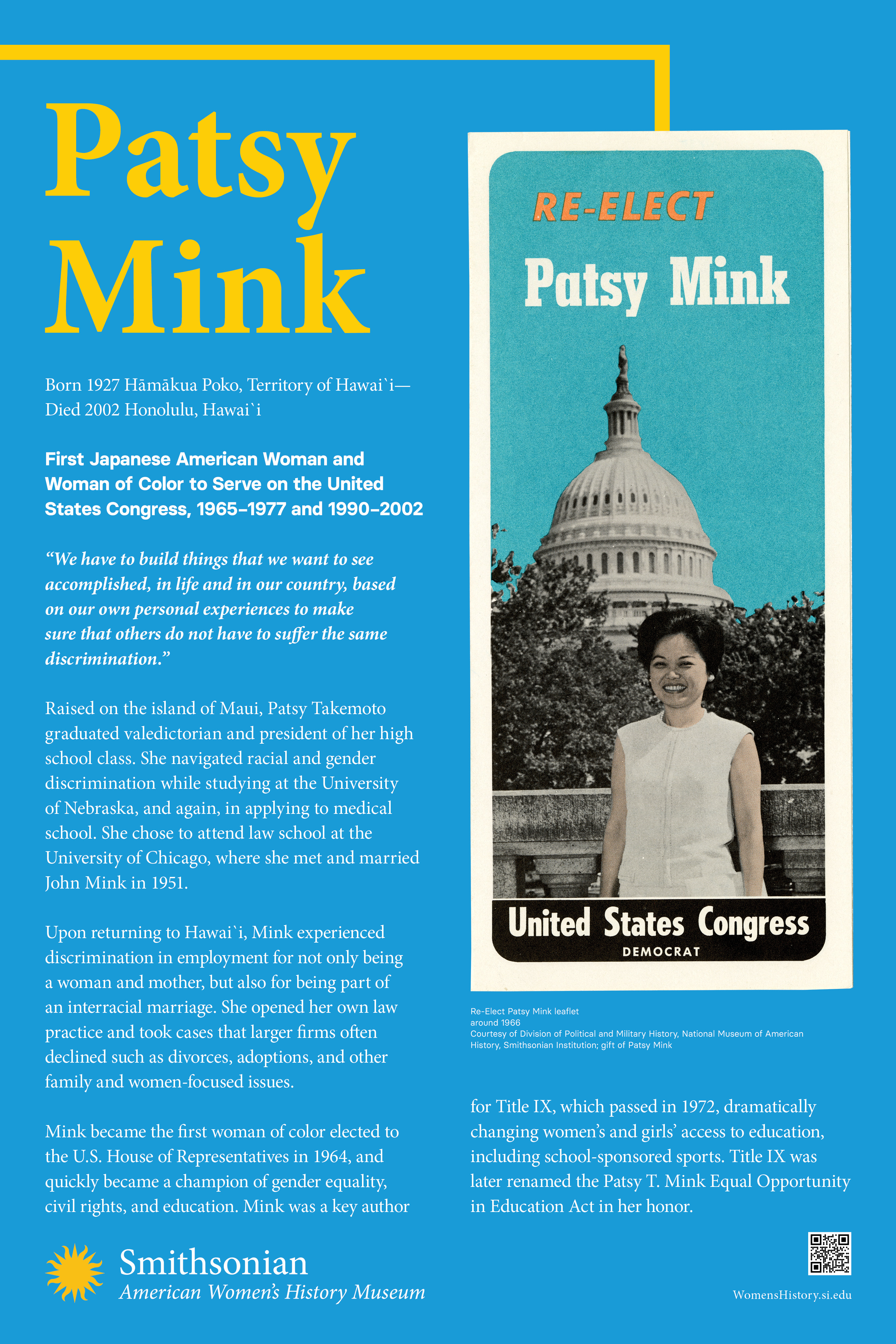
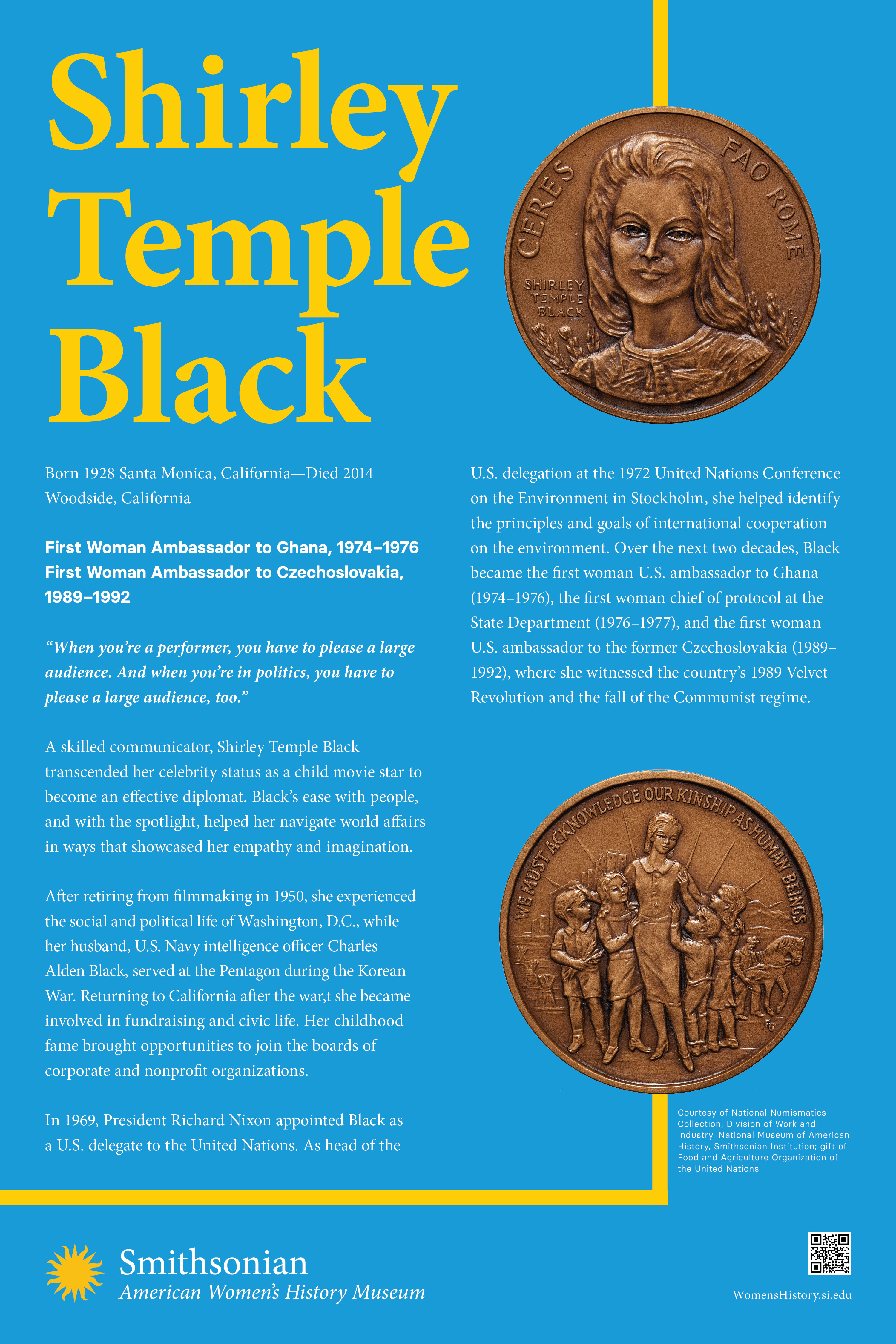
Shirley Temple Black
Born 1928 Santa Monica, California-Died 2014 Woodside, California
First Woman Ambassador to Ghana, 1974-1976 First Woman Ambassador to Czechoslovakia, 1989-1992
"When you're a performer, you have to please a large audience. And when you're in politics, you have to please a large audience, too.”
A skilled communicator, Shirley Temple Black transcended her celebrity status as a child movie star to become an effective diplomat. Black's ease with people, and with the spotlight, helped her navigate world affairs ways that showcased her empathy and imagination.
After retiring from filmmaking in 1950, she experienced the social and political life of Washington, D.C., while her husband, U.S. Navy intelligence officer Charles Alden Black, served at the Pentagon during the Korean War. Returning to California after the war, she became involved in fundraising and civic life. Her childhood fame brought opportunities to join the boards of corporate and nonprofit organizations.
In 1969, President Richard Nixon appointed Black as a U.S. delegate to the United Nations. As head of the U.S. delegation at the 1972 United Nations Conference on the Environment in Stockholm, she helped identify the principles and goals of international cooperation on the environment. Over the next two decades, Black became the first woman U.S. ambassador to Ghana (1974–1976), the first woman chief of protocol at the State Department (1976–1977), and the first woman U.S. ambassador to the former Czechoslovakia (1989– 1992), where she witnessed the country's 1989 Velvet Revolution and the fall of the Communist regime.
Courtesy of National Numismatics Collection, Division of Work and Industry, National Museum of American History, Smithsonian Institution; gift of Food and Agriculture
Organization of the United Nations
Smithsonian American Women's History Museum
Womenshistory.si.edu
Frances Perkins
Born 1880 Boston, Massachusetts-Died 1965 New York City
First Woman to Serve as a Cabinet Secretary, 1933-1945
"The door might not be opened to a woman again for a long, long time, and . . . I had a kind of duty to other women to walk in and sit down on the chair that was offered, and so establish the right of others long hence and far distant in geography to sit in the high seats."
Born Fannie Coralie Perkins, Frances Perkins was the first woman to serve as cabinet secretary in any presidential cabinet. President Franklin Delano Roosevelt appointed her as Secretary of Labor in 1933. TIME magazine recognized her historic achievement by featuring her on the cover on August 14, 1933. She was the longest serving secretary under Roosevelt.
A strong advocate of workers' rights and social equity, Perkins spearheaded the legislation for many notable New Deal era programs including: the Civilian Conservation Corps (1933), the Federal Emergency Relief Administration (1933), the National Labor Relations Act (1933), and the Fair Labor Standards Act (1938). As the chair of the committee on economic security, Perkins was involved in all aspects of investigation and planning that led to the Social Security Act of 1935.
In 1979, the United States Department of Labor headquarters building on Constitution Avenue in Washington, D.C., was named in her honor.
Frances Perkins
Samuel Johnson Woolf
1933
Drawing, charcoal and chalk on paper
Courtesy of National Portrait Gallery, Smithsonian Institution; gift of TIME magazine This portrait was used for the 1933 TIME Magazine cover celebrating Frances Perkins.
Smithsonian American Women's History Museum
WomensHistory.si.edu
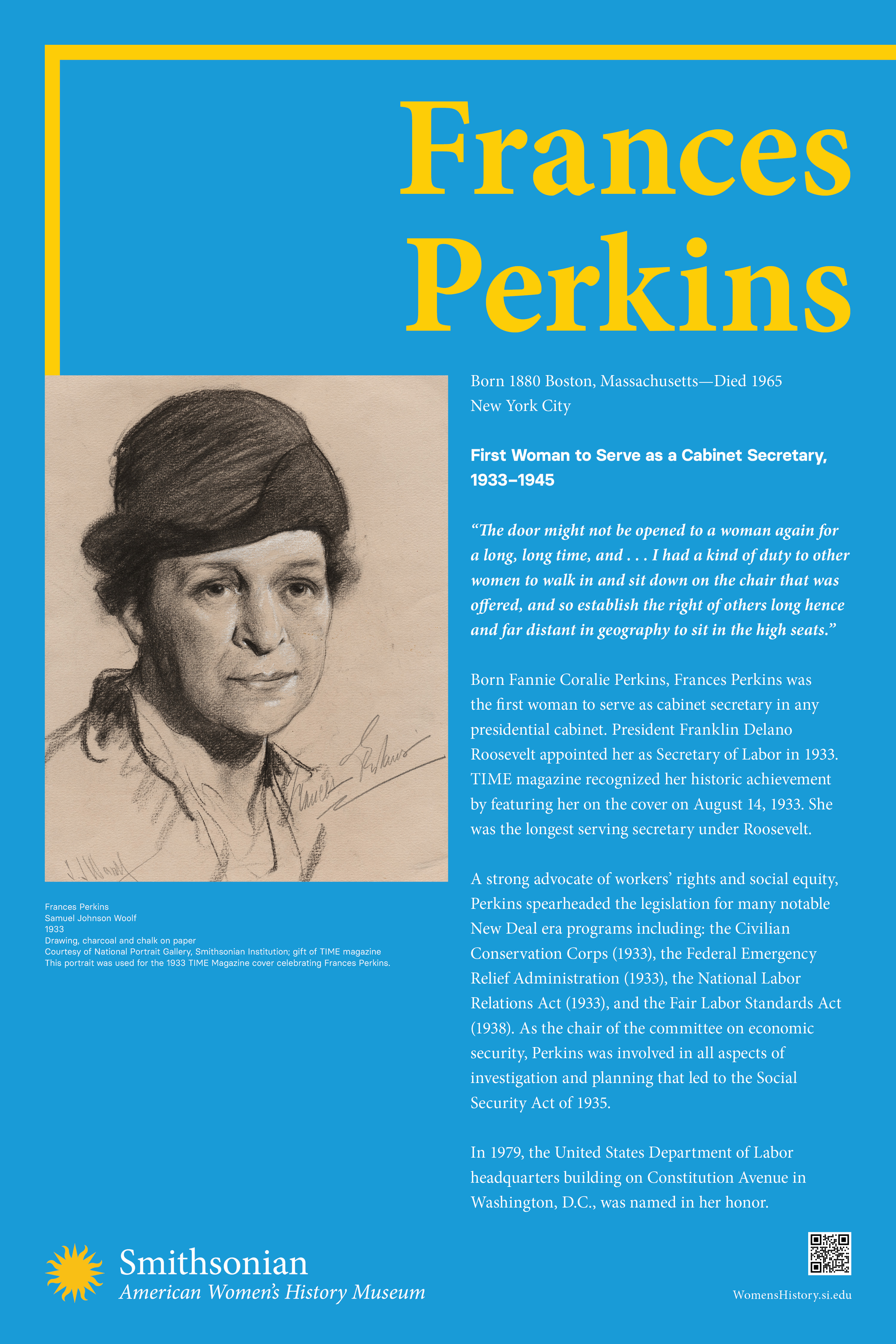
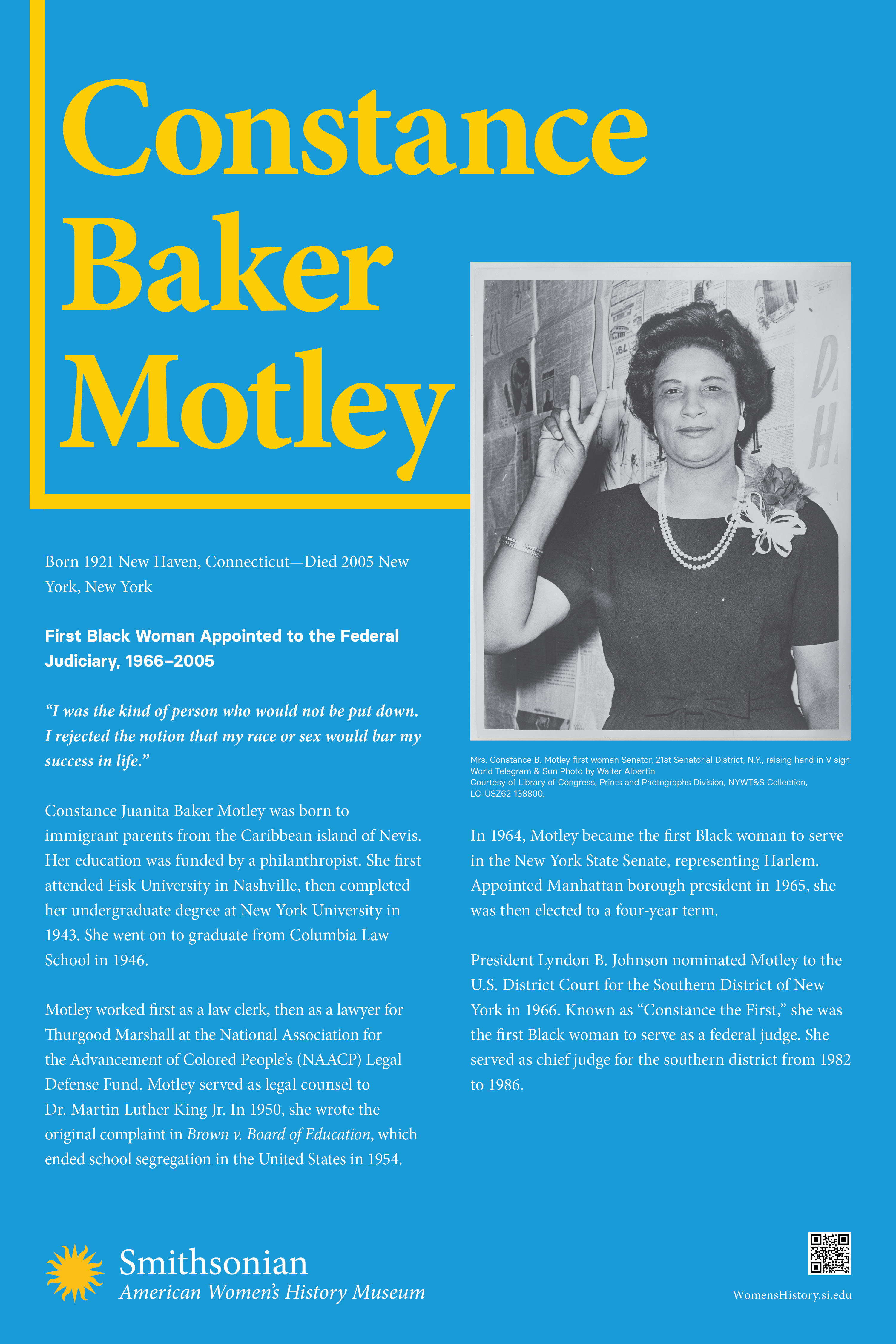
Constance Baker Motley
Born 1921 New Haven, Connecticut-Died 2005 New York, New York
First Black Woman Appointed to the Federal Judiciary, 1966-2005
"I was the kind of person who would not be put down. I rejected the notion that my race or sex would bar my success in life."
Constance Juanita Baker Motley was born to immigrant parents from the Caribbean Island of Nevis. Her education was funded by a philanthropist. She first attended Fisk University in Nashville, then completed her undergraduate degree at New York University in 1943. She went on to graduate from Columbia Law School in 1946.
Motley worked first as a law clerk, then as a lawyer for Thurgood Marshall at the National Association for the Advancement of Colored People's (NAACP) Legal Defense Fund. Motley served as legal counsel to Dr. Martin Luther King Jr. In 1950, she wrote the original complaint in Brown v. Board of Education, which ended school segregation in the United States in 1954.
In 1964, Motley became the first Black woman to serve in the New York State Senate, representing Harlem. Appointed Manhattan borough president in 1965, she was then elected to a four-year term.
President Lyndon B. Johnson nominated Motley to the U.S. District Court for the Southern District of New York in 1966. Known as "Constance the First," she was the first Black woman to serve as a federal judge. She served as chief judge for the southern district from 1982 to 1986.
Mrs. Constance B. Motley first woman Senator, 21st Senatorial District, N.Y., raising hand in V sign World Telegram & Sun
Photo by Walter Albertin
Courtesy of Library of Congress, Prints and Photographs Division, NYWT&S Collection, LC-USZ62-138800.
Smithsonian American Women's History Museum
WomensHistory.si.edu
Shirley Chisholm
Born 1924 Brooklyn, New York-Died 2005 Ormond Beach, Florida
First Black Woman to Serve on the United States Congress, 1969-1983
"If they don't give you a seat at the table, bring in a folding chair."
Shirley Chisholm was the daughter of working-class immigrant parents from Barbados and Guyana. She began her career in early childhood education in New York City but turned to full-time public service when elected to the New York State Assembly (1964– 1968). Her Spanish fluency and appeal with women's organizations helped her win New York's Twelfth District Congressional seat in 1968.
During her seven terms, Chisholm was an outspoken advocate for civil rights and a strong opponent of the Vietnam War. She coauthored a progressive childcare bill and pushed it through Congress, though it was ultimately vetoed. She was an ardent supporter of women's rights and a cofounder of the National Women's Political Caucus and the National Congress of Black Women.
In 1972, Chisholm sought the Democratic Party's nomination for president. Her fierce independence was underscored by the tagline "Unbought and Unbossed." Although her bid was unsuccessful, her pathbreaking candidacy raised the profile of issues faced by Black people and women.
Poster for presidential candidate
Shirley Chisholm
Poster for presidential candidate
Courtesy of Collection of the Smithsonian
National Museum of African American History
and Culture; gifted with pride from Ellen Brooks
Smithsonian American Women's History Museum
WomensHistory.si.edu
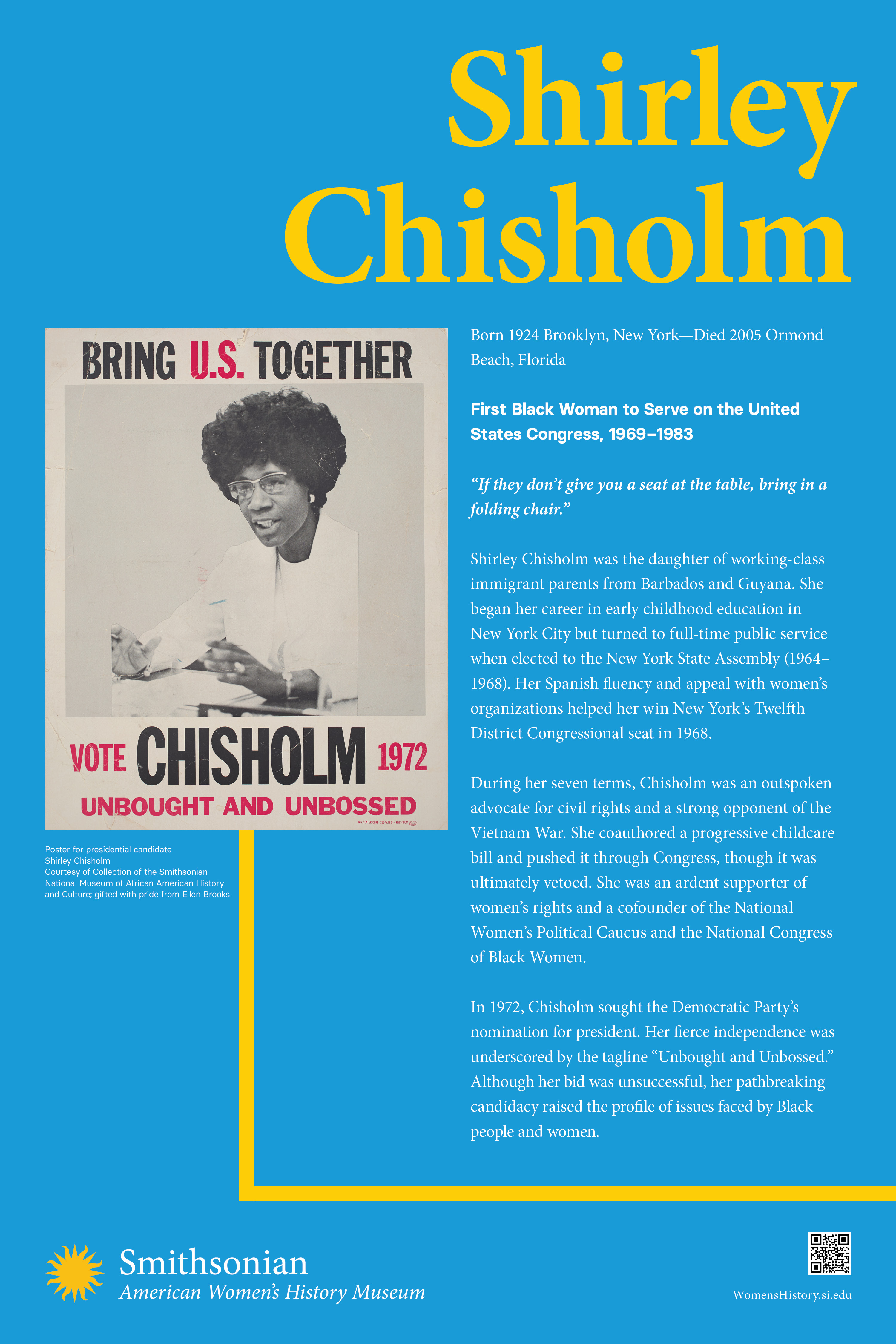
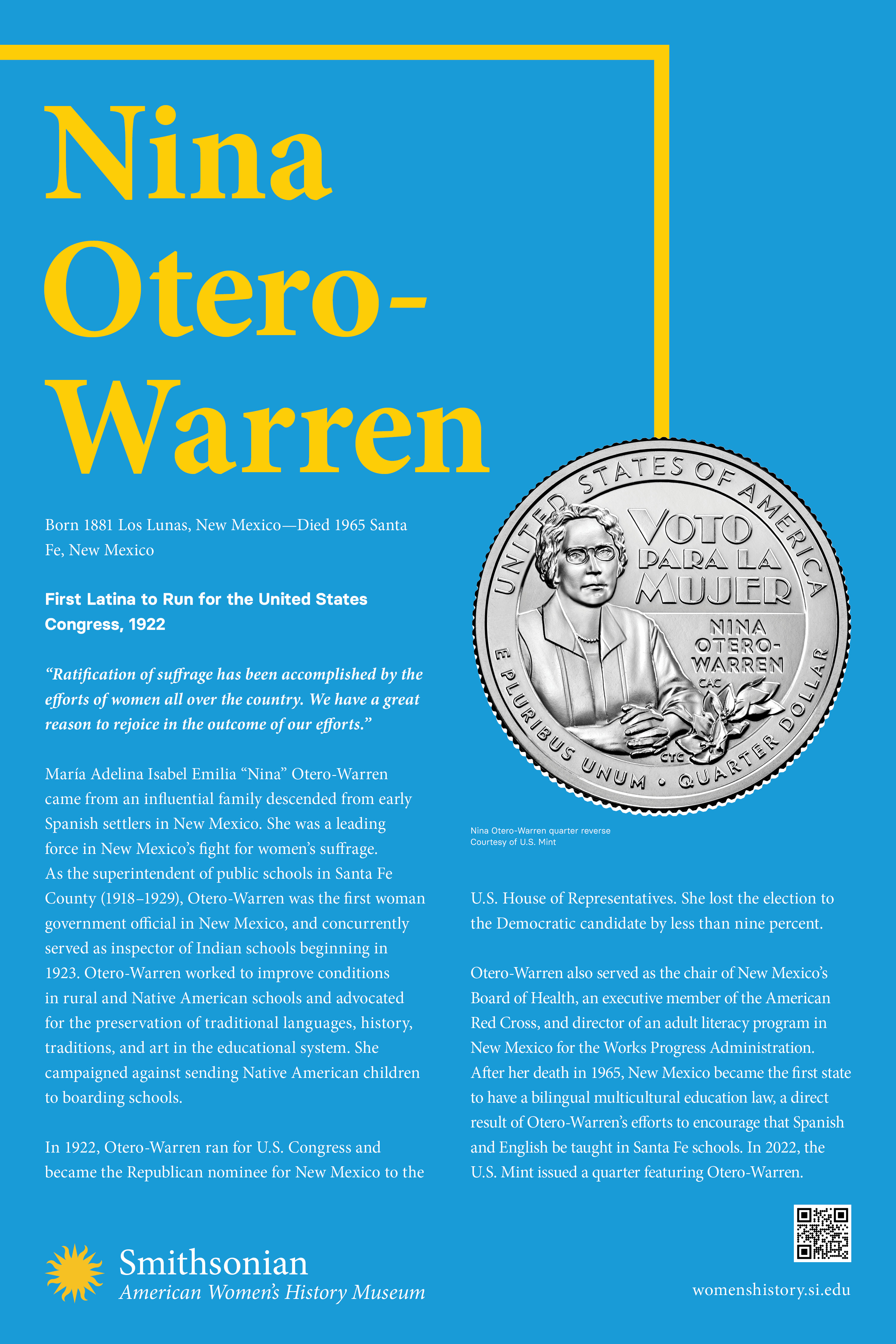
Nina Otero-Warren
Born 1881 Los Lunas, New Mexico-Died 1965 Santa Fe, New Mexico
First Latina to Run for the United States Congress, 1922
"Ratification of suffrage has been accomplished by the efforts of women all over the country. We have a great reason to rejoice in the outcome of our efforts."
María Adelina Isabel Emilia "Nina" Otero-Warren came from an influential family descended from early Spanish settlers in New Mexico. She was a leading force in New Mexico's fight for women's suffrage. As the superintendent of public schools in Santa Fe County (1918-1929), Otero-Warren was the first woman government official in New Mexico, and concurrently served as inspector of Indian schools beginning in 1923. Otero-Warren worked to improve conditions in rural and Native American schools and advocated for the preservation of traditional languages, history, traditions, and art in the educational system. She campaigned against sending Native American children to boarding schools.
In 1922, Otero-Warren ran for U.S. Congress and became the Republican nominee for New Mexico to the U.S. House of Representatives. She lost the election to the Democratic candidate by less than nine percent.
Otero-Warren also served as the chair of New Mexico's Board of Health, an executive member of the American Red Cross, and director of an adult literacy program in New Mexico for the Works Progress Administration. After her death in 1965, New Mexico became the first state to have a bilingual multicultural education law, a direct result of Otero-Warren's efforts to encourage that Spanish and English be taught in Santa Fe schools. In 2022, the U.S. Mint issued a quarter featuring Otero-Warren.
Nina Otero-Warren quarter reverse
Courtesy of U.S. Mint
Smithsonian American Women's History Museum
WomensHistory.si.edu